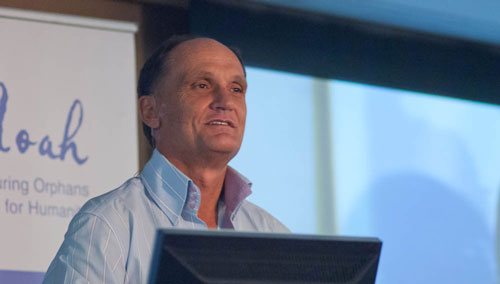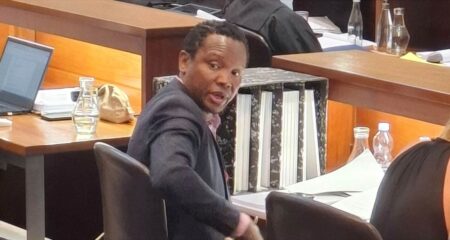
He says government needs to move faster on issuing access to new radio frequency spectrum and ensure it goes to those best suited to use it. He says Cell C’s size makes it more agile than its competitors in a market that is going to become marked by low margins from, and high quantities of, data consumption.
Knott-Craig is set to take charge at Cell C next Monday, 2 April, and says he has no qualms admitting that his leadership style is “autocratic”. He says that the staff at Cell C will come to know him in time, but that there is no time for introductions when he starts in his new position because of the need to get out of the gates as fast as possible.
According to Knott-Craig, there are three things governing technology in the telecommunications industry — social networks, the demand for data, and the growing prevalence of smartphones.
“Social networks are going to own the customer,” he says. “That’s the next value proposition for social networks: ‘We’ll choose your bank, we’ll choose your telco, maybe a few of each to best suit your profile at different times of day’. Social networks are very good at using information about customers very smartly; telcos are not as smart about using the data they have about their customers.”
Knott-Craig says consumers have also changed their approach to services and don’t necessarily want to have to go into physical outlets anymore. “I choose my bank by which one has the best electronic banking,” he says. “Do people really want to have to go into a store to buy a starter pack? I don’t think so anymore.”
He says Apple’s iPhone, and smartphones in general, have demonstrated to consumers that things can be simpler, but service providers have yet to catch up with this in their business models. “Think about the models in fixed and mobile today; they’re tedious.”
Knott-Craig says customers should be able to change their package every day if they wish to, and that operators should have systems so efficient and responsive that a new package can be rolled out in 12 hours.
He says smartphones are also, inevitably, going to increase the demand for data exponentially. “The margins on data are thin, but demand way exceeds supply, which is the only reason we have margins at all.”
Knott-Craig says data is on an “infinite growth path with a very thin margin” and that to date it “has been subsidised by fat margins on voice” but that those are disappearing because soon voice will be routed via data, too.
Though SA’s international capacity is “looking good”, there remains a deficit in national core capacity. This will need to change quickly if network operators are to adapt to the data demands of consumers.
It is equally important that operators cut costs wherever possible, he says. Knott-Craig says staff at telecoms operators “will have to become more productive” and operators cannot continue to “build full networks in terms of civil infrastructure; there has to be some kind of getting together of minds”. He says infrastructure sharing results in “less impact on the environment and reduce costs; it’s good for everyone”.
Knott-Craig warns it is unrealistic for networks to expect to be able to charge more for faster networks and greater data consumption. “Consumers want a lower price, but we can’t increase the speed of data and expect to increase the cost. The price has to come down at something close to the rate at which speeds go up.”
The key question facing all operators is how to remain profitable in the long term. “This is excellent news for Cell C. We’re relatively small, so we have much less to lose when drastic things have to be done.”
On the topic of radio frequency spectrum, Knott-Craig says Cell C’s comparatively small user base, combined with its having the same amount of spectrum as its competitors, should equate to “a comparable network in terms of coverage and quality, and preferably one that offers even better quality. We should have twice the service quality. We have the same spectrum with a third of the traffic. We just have to make sure [the network] is built properly.”
Knott-Craig says the fact that networks have the same amount of spectrum means an equilibrium must be reached between large and small players and that “operators need to become competitive within themselves”.
He also wants to see the aftersales service market revamped. “You have to have places where you can provide care, whether over the phone or in person. Call centres are often just about statistics, not about helping people… We have to change the way call centres are run and thought about.”
The fact that Cell C isn’t listed is another advantage, according to Knott-Craig. “There’s no need for one eye on the share price all the time,” he says. “We can just focus on the business.”
He says it means the company can also talk to the media if and when it wishes to without worrying about shareholders, and that it allows for more innovative marketing campaigns because failures can be withdrawn quickly while successes can be allowed to run for longer periods than normal.
On the target of 25% market share, Knott-Craig says this is what Cell C needs to be sustainable and, although he can’t guarantee the company will get there in three years, “if we don’t have a target we won’t reach it”.
He is nevertheless optimistic about the operator’s prospects. “Churn [in the industry] is 40% a year; it’s not that difficult to get market share.” Churn is the process whereby consumers move from one network to another to take advantage of deals or try to get better call rates or services.
“Spectrum is the single biggest factor for the cost of a network. Until we as a country decide it’s a scarce resource and that it should go to people that can use it properly, costs will stay high,” he says.
“Government needs to realise that digging trenches for fibre isn’t a sin,” he adds. “We need to get local municipalities on board, too. Some customers want low prices, high speed, perfect coverage, but no base station in their area. That’s just not possible. Local communities have to understand how these things work.”




